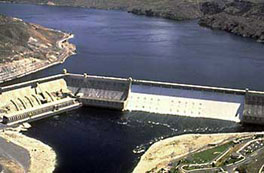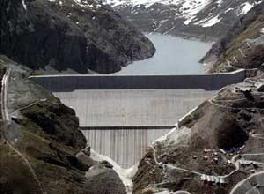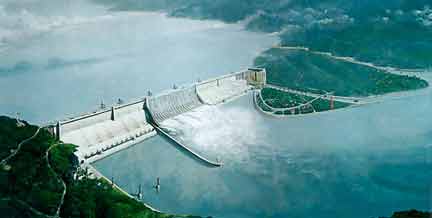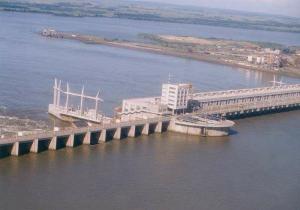
Itaipu Dam, Paraguay

Itaipu Dam, photo: Itaipu Binancional

Itaipu dam obstructs the Paraná River

Glen
Canyon Reservoir. Photo: Ron Terpening

Glen Canyon and bridge downstream.
Photo: Ron Terpening
The Glen Canyon dam is a concrete arch dam located two miles northwest of Page, Arizona on the Colorado River. Built from 1957-1964, the dam has one of the largest man-made reservoirs in the world— Lake Powell. Edward Abbey called the dam "the most hated structure in the West." The dam is 1,560 feet long at its crest, 300 feet thick at the base and 25 feet thick at the top. It rises to a height of 587 feet and contains 4,901,000 cubic yards of concrete.
Lake Powell 

Hoover Dam with Lake Mead (top) and the tamed Colorado River (bottom).
Photo: Bureau of Reclamation
Lake Mead is the fifth busiest U.S. national park.

Grand Coulee Dam. Photo: Bureau of Reclamation
Grand Coulee was constructed from 1933-1942, with later modifications. It contains 11,975,520 cubic yards of concrete and is 500 feet thick at its base. The crest is 30 feet wide and extends for 5,223 feet, just 57 feet short of a mile. The dam is 550 feet in height.

Grand Dixence

Yellowtail Dam, Montana (small, but worth a quick look)

Photo: Entidad Binacional Yacyretá
|
Dams Around the World One of the protagonists in Tropic of Fear, Walter Stanek, is a hydrogeologist, in Paraguay to conduct an environmental impact study on the proposed Corpus Christi dam, planned for the Paraná River between Itaipu and Yacyretá dams. Itaipu dam is equivalent in height to a 65-story building (196 meters). The volume of earth excavated for the dam was 8.5 times that of the Eurotunnel (between France and England) and it has 15 times as much concrete. The Itaipu dam, a joint Paraguayan-Brazilian project, began production in 1985. |
||||||||||||||||||
Paraguay claims that Itaipu is the world's largest dam, although the Chinese might disagree with them. Here are some comparable data:
 Three Gorges Dam, China. Photo Dr. Kamran M. Nemati |
||||||||||||||||||
No discussion of dams can ignore Glen Canyon Dam in Arizona and Edward Abbey's novel The Monkey Wrench Gang. One of the book's memorable scenes depicts Seldom Seen Smith kneeling on top the dam and praying for an earthquake to destroy the dam and unplug the Colorado River. |
||||||||||||||||||
|
||||||||||||||||||
Hoover dam, located 30 miles southeast of Las Vegas on the border between Arizona and Nevada, was built from 1931-1936. Completed two years ahead of schedule, the dam is the second highest in the United States (at 726.4 feet). The dam is 660 feet at its base and 45 feet thick at the crest, containing a total of 4.36 million cubic yards of concrete. Over 100 workers died in the construction of the dam and its four diversion tunnels. Photo: Bureau The dam's 17 main turbines generate 2,074 megawatts of power, much of which is transmitted the 266 miles to Los Angeles. |
||||||||||||||||||
In Tropic of Fear, the protagonist's father and grandfather both worked on Grand Coulee Dam, which is the largest in the United States.
Located in the state of Washington (28 miles northwest of Coulee City and 82 west of Spokane), Grand Coulee Dam generates power from the Columbia River.
|
||||||||||||||||||
Other large dams around the world, each with its own claim to fame, include the following:
But the dam I will conclude with is another one in Paraguay, the Yacyretá, which is co-owned by Paraguay and Argentina and is located upstream on the Paraná River. Completed in 1999, the dam is not yet generating at full capacity, generating 2,700 megawatts. The reservoir will only reach its intended height in 2008. |
||||||||||||||||||
Yacyretá
Dam  |
||||||||||||||||||
Humans have built dams since at least the third millennium B.C. Today, approximately 500 new dams are constructed around the world every year. Tropic of Fear deals in part with the effects of these dams on the environment.
|
||||||||||||||||||
Home Sitemap




